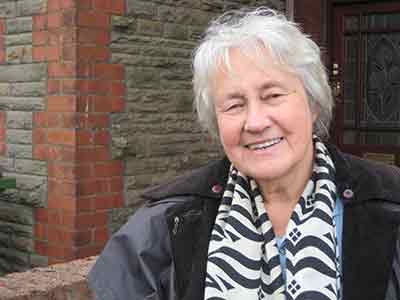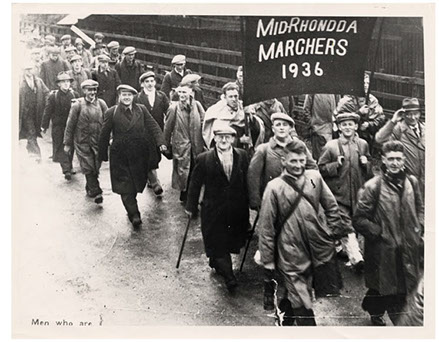
Chartists and Hunger Marchers
 Elin Phillips shares her preparation for a Radio Wales talk about the famous Jarrow March a hundred years ago. She discovered Welsh miners were the first to march – and they marched in the footsteps of the CHARTISTS
Elin Phillips shares her preparation for a Radio Wales talk about the famous Jarrow March a hundred years ago. She discovered Welsh miners were the first to march – and they marched in the footsteps of the CHARTISTS
At the beginning of November every year we remember and celebrate the Chartist March to Newport in 1839. We think of those hungry, desperate people who struggled and suffered, and who took up arms in the cause of justice and freedom. In October 2016 we also remembered the Jarrow Marchers, the hungry, desperate out-of-work miners who marched to London from Jarrow in October 1936 – almost exactly a century after the Chartists. They were unarmed, and their intention was simply to draw public attention to their situation, but their cause was the same – justice for ordinary people, and the chance to live decent lives, un-blighted by poverty. The Jarrow March, although it is now the most famous, was not the first march by the unemployed during the Depression years. The very first hunger march started from south Wales in the autumn of 1927, following the failure of the General Strike in 1926. During all these years of organised marches, unemployed men were wandering the countryside in a desperate search for any form of paid work. Taking off in collective group formation, seeking support in the places they passed through, was a logical and positive development. It drew public attention to their plight but importantly proclaimed their unemployment was a social problem, not personal failure.
When I was invited to appear on that excellent programme Sunday Supplement (Radio Wales) to talk about the Jarrow March, I thought I had a pretty clear idea, therefore, of what I was going to say - and knew I could make a good link to the Chartists and to this year's Convention. But as I did my research, I realised that there were closer and more direct links to the Newport Rising.
The intention of the 1927 marchers was to protest against the new Unemployment Bill, and the refusal of relief to unemployed miners and their families. It began in the Rhondda, with a demonstration in October attended by about 10,000 people, and addressed by A.J. Cook and other miners' leaders. Two hundred and seventy marchers from the Rhondda and some of the other mining valleys then walked to London with the aim of arriving for the opening of Parliament on November 8th and ‘interviewing’ government ministers. The march was not officially supported by the Labour Party, the TUC or even the South Wales Miners' Union. It met with hostility, particularly in the press and had little success in London. The main reason for this was the close links between the National Unemployed Workers' Movement, which organised the march, and the Communist Party. The march did succeed in drawing attention to the terrible conditions in the mining areas, and more hunger marches were organised in these areas as the economic situation deteriorated still further.
Following further cuts to unemployment benefit in August 1931, a South Wales Hunger March was organised that ended at the TUC conference held that September in Bristol. At least 112 men and women walked to Bristol, where they were refused a hearing by the TUC and their march was broken up by mounted police using batons.
 Despite this, the marches continued in south Wales – still organised by the NUMW, but more localised, with the aim of putting pressure on the local authorities implementing the government's policies. Marches to London continued, with 375 marchers from south Wales joining a mass march of over two and a half thousand from various parts of Britain to London in October 1932. The intention on this occasion was to present a petition to Parliament on 1 November, but they met with the same hostility as before. In their account of this, Hywel Francis and Dai Smith comment 'There were elements of panic resembling that experienced by the authorities prior to the Chartist demonstration in London in 1848'.1
Despite this, the marches continued in south Wales – still organised by the NUMW, but more localised, with the aim of putting pressure on the local authorities implementing the government's policies. Marches to London continued, with 375 marchers from south Wales joining a mass march of over two and a half thousand from various parts of Britain to London in October 1932. The intention on this occasion was to present a petition to Parliament on 1 November, but they met with the same hostility as before. In their account of this, Hywel Francis and Dai Smith comment 'There were elements of panic resembling that experienced by the authorities prior to the Chartist demonstration in London in 1848'.1
The next hunger march in south Wales in1933 made even closer links with Chartism. A petition organised in the valleys of Monmouthshire attracted over 17,000 signatures and a march to Newport was called. The petition listed ten demands, including the abolition of the hated 'Means Test', the re-starting of work on the Newport-Chepstow road at trade union rates, for two substantial meals to be provided for school children every day, that the unemployed should be given coal, and that the seven hour day for miners be re-introduced. The petition also asked – very realistically – that the marchers should meet with members of the council, and be given free transport home. These were the only two demands to which the Monmouthshire County Council agreed and only after much protest by the marchers.
The march began in Brynmawr on 29th August, and followed the Chartist route of 1839 through Crumlin to Risca. By the time it reached Newport the following day, there were a thousand marchers. They received many demonstrations of support along the way, from businesses as well as chapels and churches, and it was estimated that 50,000 people lined the route between Crumlin and Cwmcarn and 20,000 took part in the demonstration in Newport. Despite this evidence of sympathy for the cause of the unemployed – or perhaps because of it – the police were out in force in Newport to greet the marchers as they arrived at the Monmouthshire County Council offices at Pentonville. The councillors were only prepared to meet a deputation of three, who presented the petition, - and the leaders had to engage in a sit-down protest to get the transport home they expected.
The marchers themselves were aware that they were following literally in the footsteps of the Chartists. The Monmouthshire Hunger March, the commemorative pamphlet published by the Monmouthshire Marchers' Council repeatedly invoked the memory of the Chartists, referring frequently to the 'spirit of the Chartists', stating that the marchers of 1933 were continuing 'the radical tradition within the county’, and saying bitterly 'If their Chartist forbears had marched in the Hungry Forties of the last century, their descendants would march in the Destitute Thirties of our era'2
As I found out as I prepared to talk about the Jarrow Marchers of 1936, theirs was not the first of the Hunger Marches, nor the only one. It was in fact the last of the Hunger Marches. However, it was the most successful, since it had the official support of the Labour Party – and by 1936 the economy was already gearing up for war. When we remember the Chartists of 1839, their struggles and suffering, we should also think of their starving descendants in the 1930s. As a former history teacher, I feel ashamed that I knew so little of their struggles and suffering, although it happened so much more recently. And I wonder how many school children learn about their great-grandparents' struggle in the 1930s – and how many about Hitler's Mein Kampf?
Welsh Miners Library Swansea









